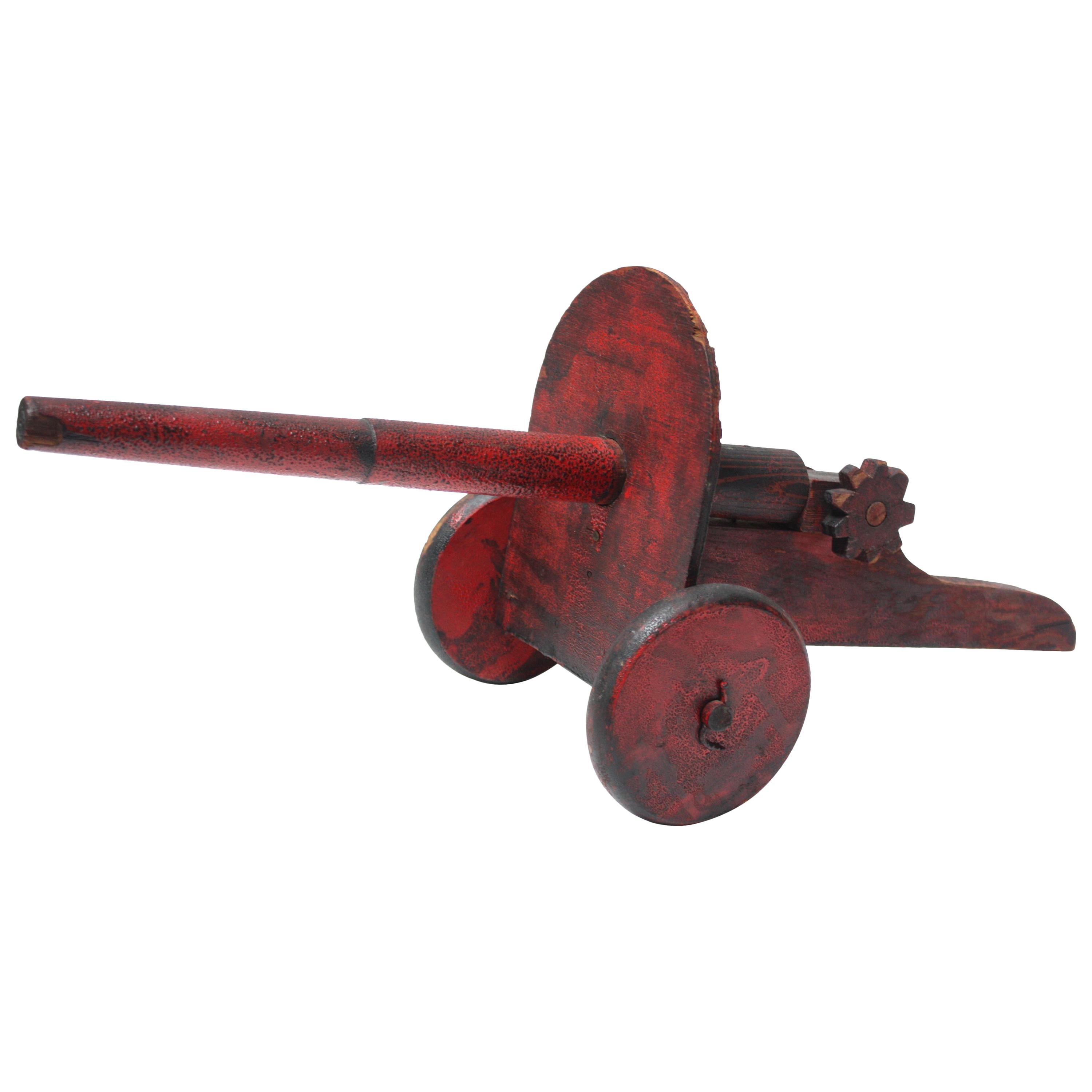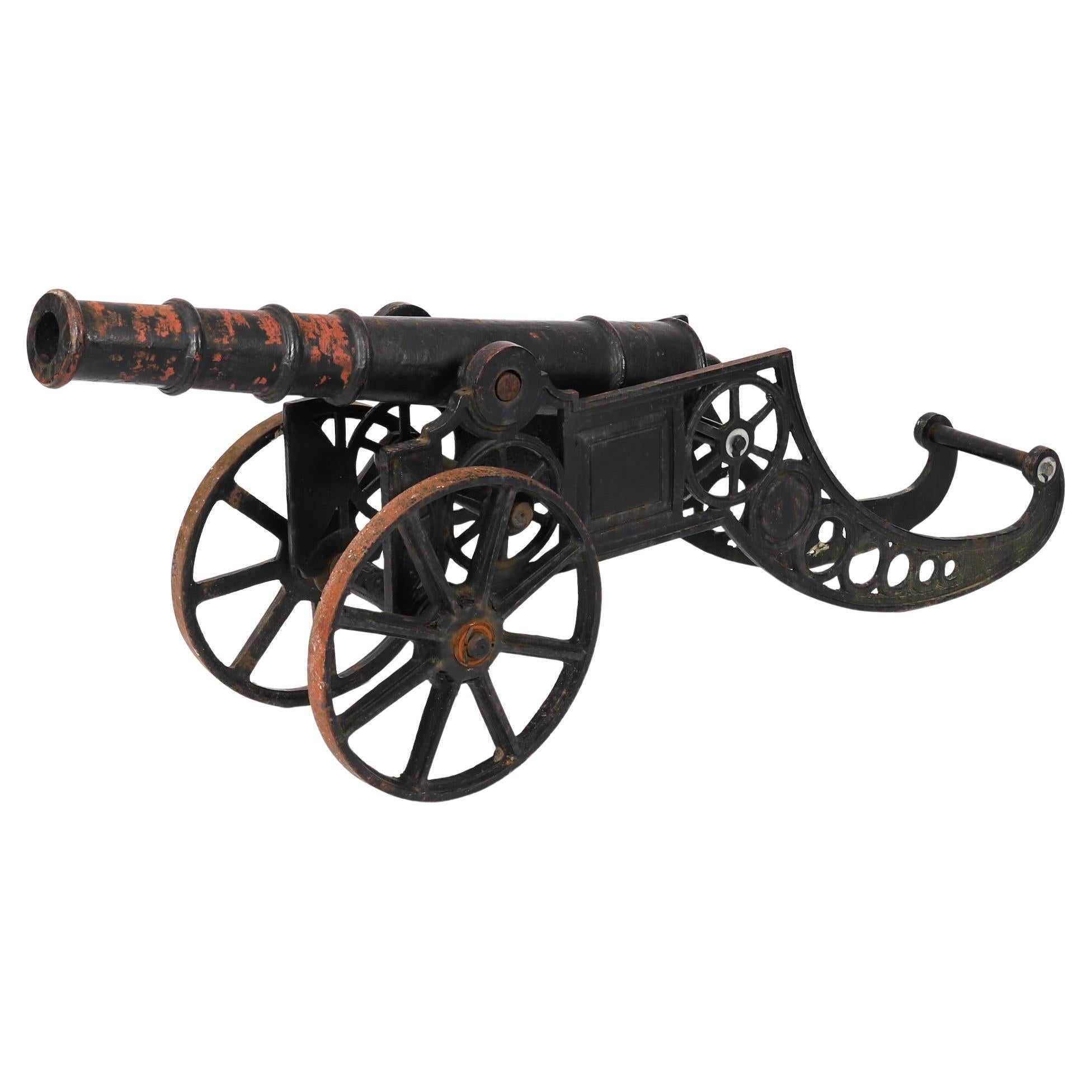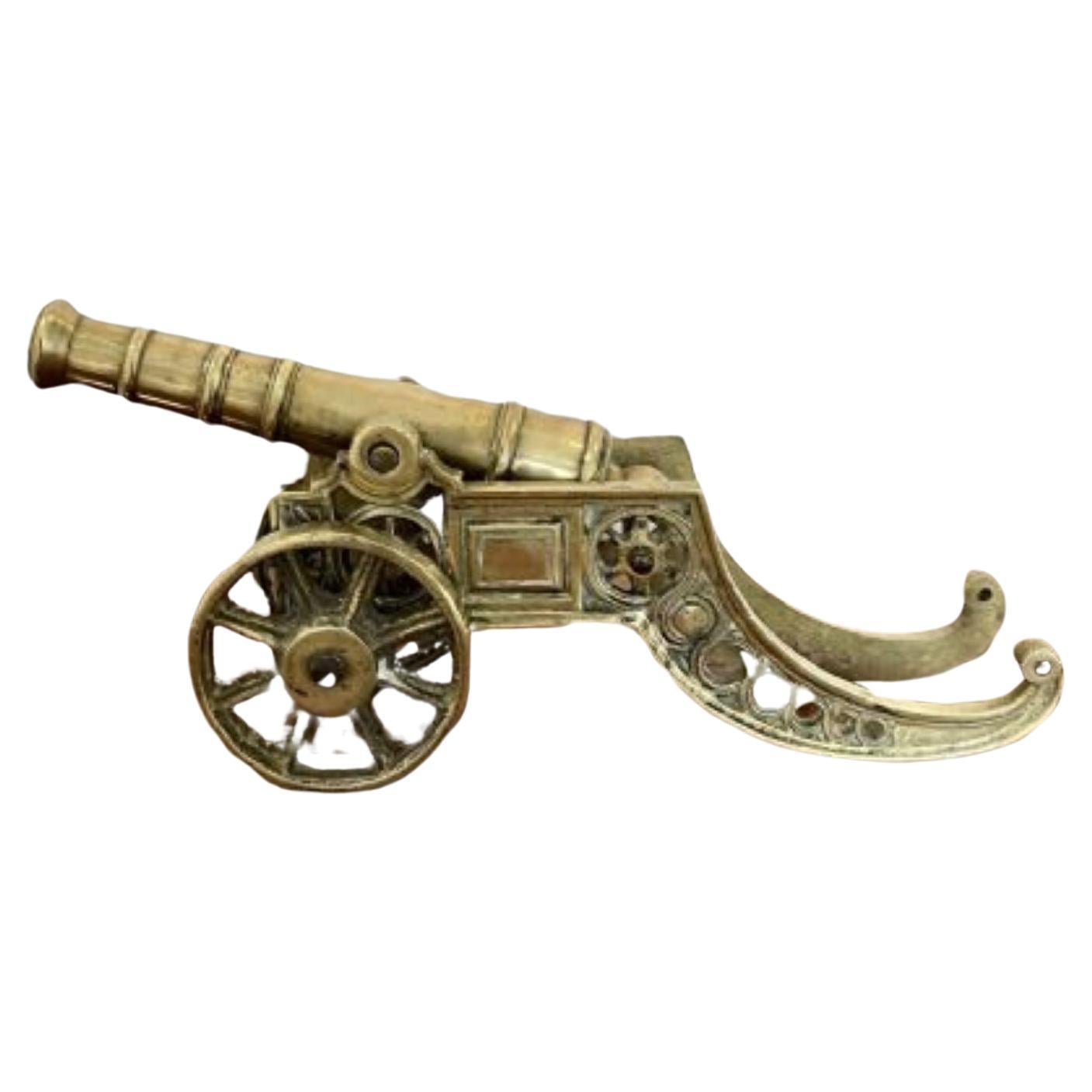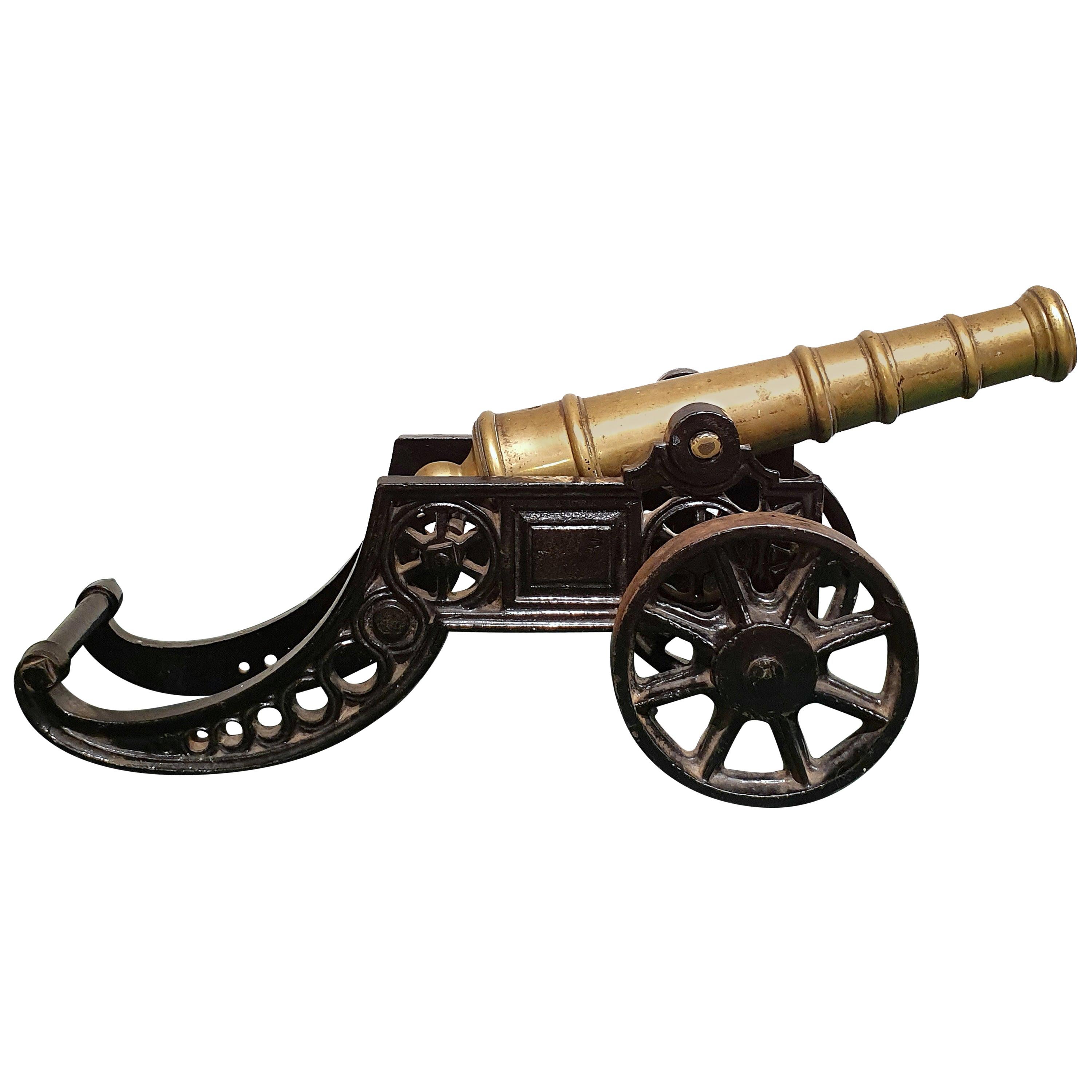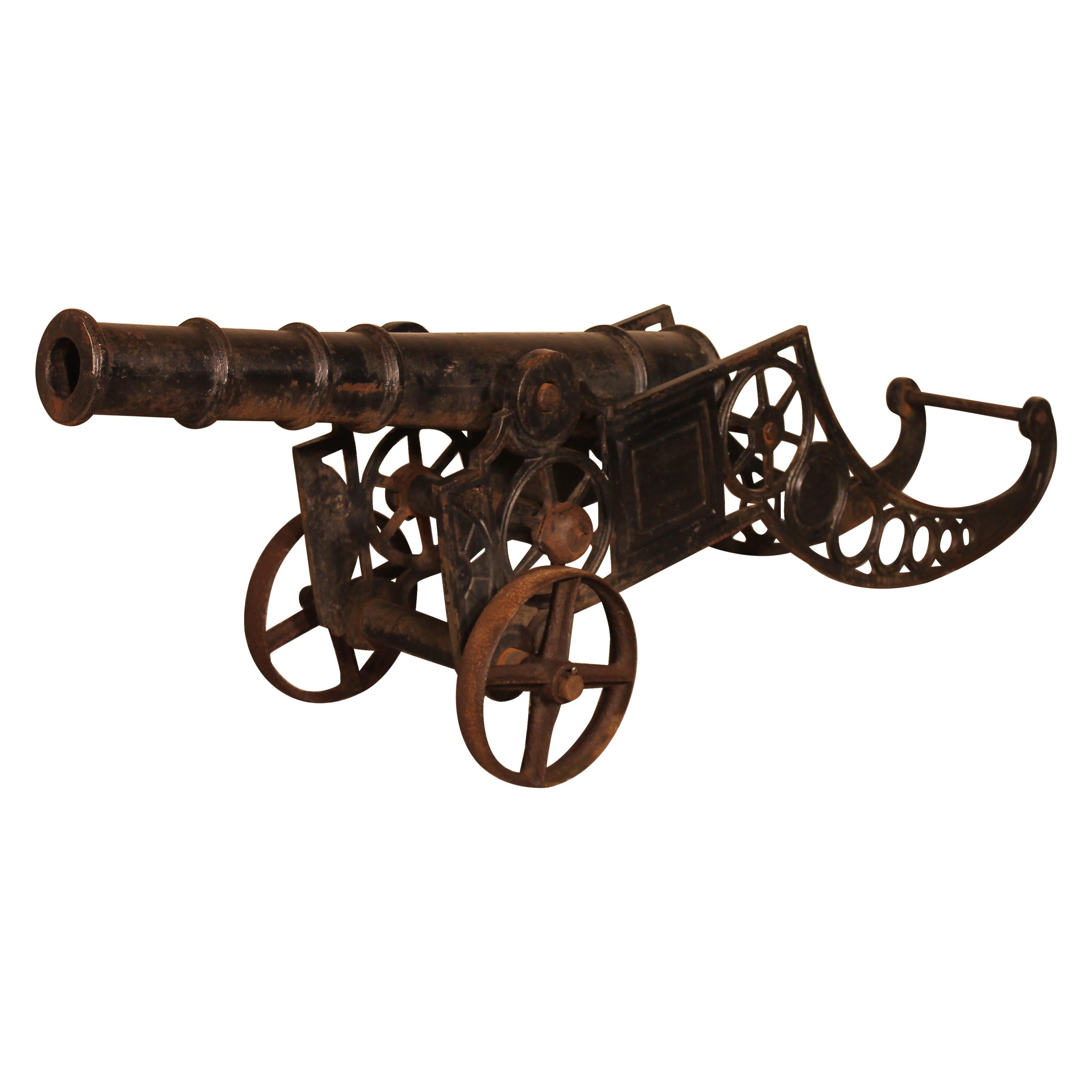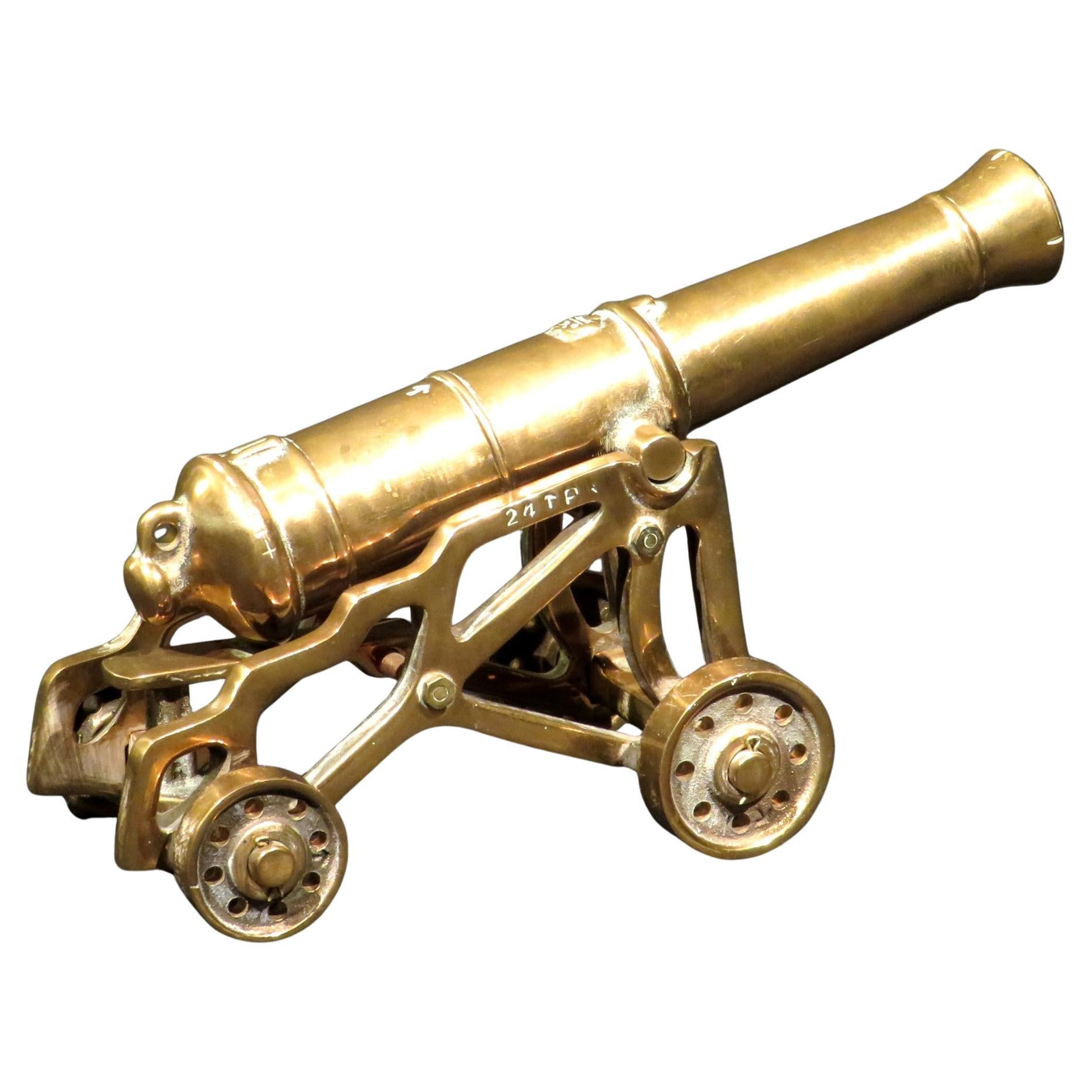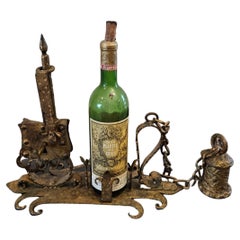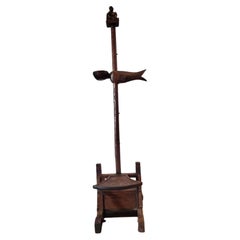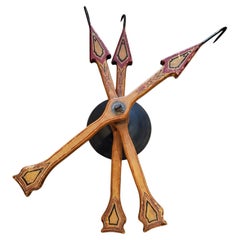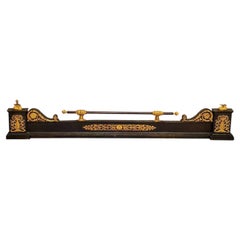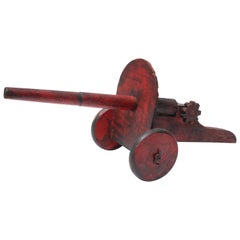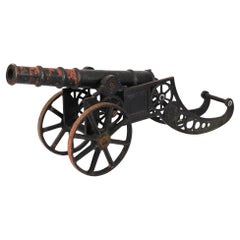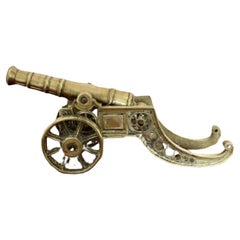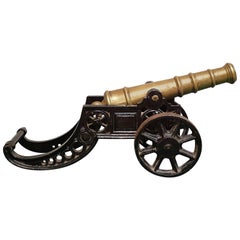Items Similar to Large Antique English Trench Art Table Cannon
Want more images or videos?
Request additional images or videos from the seller
1 of 21
Large Antique English Trench Art Table Cannon
$3,300
£2,482.94
€2,868.59
CA$4,663.76
A$5,063.94
CHF 2,681.73
MX$62,069.38
NOK 33,187.41
SEK 31,360.35
DKK 21,409.95
About the Item
Antique English Trench Art mixed metal miniature howitzer - signal style table cannon. Hand-crafted, assembled in the early 20th century, fashioned in part from spent shell casings, older brass, bronze, and copper elements, including a heavy brass barrel embellished with sculpted rails, applied stars and decorative studs, engraved "WORLD," with interlocking initials "VZ," and various original markings; seated in an ornate openwork frame decorated with Bacchanal putti, trailing grapevines, wine casks, engraved on one side "Victoria," opposite side engraved "God Save the Queen," rolling on large pierced metal wheels, flanking central gilt bronze ormolu Bacchus mask mount.
A truly superb specimen, very large size, high level of quality, and unusually decorative design, it makes for a fascinating sculptural object, interesting historical work, and one-of-a-kind conversational piece, sure to appeal to a variety of collectors, including militaria, world history, military folk art, especially WWI and WWII, 19th century Victorian era decorative art and antique statue, small scale weapon models, and more.
Dimensions: (approx)
21" long, 11.5" high, 5.25" wide, 8lbs
The definition of what exactly can be counted as trench art varies, but it is widely accepted to center on World War I, where soldiers in the stretching, brutal battles created art with the remnants of war. Despite its name, trench art wasn’t usually done right in the muddy trenches, but rather after or by wounded soldiers, or often by prisoners of war. Yet no matter the point where it was made, whether right on the battlefield or in a hospital or in a prison, when trench art left conflict it gradually became this anonymously created, tangible memory of violence that can fade into history as quickly as it can destroy.
Trench art is a term used to describe objects made from the debris and by-products of modern warfare. Trench Art is typically associated with the First World War, although similar items have been produced in numerous other conflicts.
Most trench art was made by servicemen to pass the time when not in the front line. While much of it was simple and amateur, the production of some examples required metalworking skills or even workshop facilities. Prisoners of war (POW), faced with a constant battle against boredom, were also known to produce these items.
Later, other examples of trench art were also made by local civilians for sale to soldiers. This manufacture often drew upon traditional local crafts, such as metalworking or lace-making. Despite the danger from these potentially deadly items, many civilians would collect debris from battlefields to transform into souvenirs out of necessity to survive and produce what little income they could in their war ravaged homeland.
Most every military museum has some trench art as a curio in its collection, but there’s recently been a move away from treating it as an oddity and towards using it as insight into the experience and processing of war through art.
You might expect lots of bombastic, patriotic imagery in trench art, but it actually tended to be the opposite.
“It is one of the ironies of metal trench art, and decorated bullet cases in particular, that most were decorated with pastoral motifs such as flowers, leaves, and romanticized images of women typical of the Art Nouveau style which had flourished since the 1890s.” Nicholas J. Saunders wrote in the 2011 edition of his Trench Art: Materialities and Memories of War
Most of it has a surprising elegance, and while it may not have been the intention of the soldiers, it gives an odd reminder that these weapons are in the end just materials, and can by human hands can be formed into both instruments of death and objects of beauty.
- Dimensions:Height: 11.5 in (29.21 cm)Width: 21 in (53.34 cm)Depth: 5.25 in (13.34 cm)
- Style:Folk Art (In the Style Of)
- Materials and Techniques:
- Place of Origin:
- Period:
- Date of Manufacture:circa Early 1900s
- Condition:Wear consistent with age and use. Minor structural damages. Excellent original antique condition. Presents splendidly, with nicely aged patina over the whole. Primitive untrained folk art construction with expected imperfections, retaining original antique character, including minor bending throughout.
- Seller Location:Forney, TX
- Reference Number:1stDibs: LU5977231848312
About the Seller
4.8
Platinum Seller
Premium sellers with a 4.7+ rating and 24-hour response times
Established in 2013
1stDibs seller since 2021
296 sales on 1stDibs
Typical response time: <1 hour
- ShippingRetrieving quote...Shipping from: Forney, TX
- Return Policy
Authenticity Guarantee
In the unlikely event there’s an issue with an item’s authenticity, contact us within 1 year for a full refund. DetailsMoney-Back Guarantee
If your item is not as described, is damaged in transit, or does not arrive, contact us within 7 days for a full refund. Details24-Hour Cancellation
You have a 24-hour grace period in which to reconsider your purchase, with no questions asked.Vetted Professional Sellers
Our world-class sellers must adhere to strict standards for service and quality, maintaining the integrity of our listings.Price-Match Guarantee
If you find that a seller listed the same item for a lower price elsewhere, we’ll match it.Trusted Global Delivery
Our best-in-class carrier network provides specialized shipping options worldwide, including custom delivery.More From This Seller
View AllAntique Architectural Parcel Gilt Wrought Iron Sculpture
Located in Forney, TX
A one-of-a-kind antique wrought iron sculpture, comprising 18th and 19th century architectural elements, in a rustic parcel gilt finish, including door lock, latch, and skeleton key,...
Category
Antique 19th Century European Folk Art Mounted Objects
Materials
Bronze, Wrought Iron
19th Century Provincial Chinese Floor Lamp Candle Torchiere
Located in Forney, TX
A scarce antique Chinese carved hardwood, most likely elm, adjustable candlestick stand floor torchère with beautifully aged warm rich pat...
Category
Antique 19th Century Asian Candle Lamps
Materials
Elm
Antique Early Gambling Folk Art Gaming Device, Holtz
Located in Forney, TX
An exceptionally scarce antique American Folk Art gambling triple stacked wooden arrow spindle spinning wheel gaming device from the late 19th / early 20th century.
Believed to be a prototype or for a similar lesser known model of the important, very rare and unusual T. F. HOLTZ made "Three Arrow Trade Stimulator" circa 1896, (displayed in the American Antique Museum, reference L2016.2501.010)
Theodore Holtz of San Francisco and early slot machine pioneer Charles Fey's partner in 1894, forming their first partnership as Holtz and Fey Electric Works. For this particular game, upon depositing your nickel and pressing the lever, three arrows will spin on the front dial and if all three stop on the same marker you win.
Trade stimulators were countertop or freestanding amusement gaming machines widely used to encourage shoppers to indulge in a game of chance. They became popular in American saloon bar...
Category
Antique 19th Century Folk Art Carnival Art
Materials
Metal, Iron
T. Boone Pickens 19th Century French Empire Period Fire Fender
Located in Forney, TX
A rare and important period French Empire dore bronze mounted iron fire fender, with rich provenance, adding character and historic depth, it's from the home of iconic American busin...
Category
Antique Early 19th Century Empire Fireplace Tools and Chimney Pots
Materials
Bronze, Iron, Ormolu
Antique India Patinated Brass Changalvetta Hindu Ritual Oil Lamp with Ladle
Located in Forney, TX
Add authentic antique character and charm, sophisticated cultural interest, elegant warmth and rich historical depth with this graceful South Indian patinated cast brass ritual oil l...
Category
Antique 19th Century Indian Metalwork
Materials
Brass, Bronze
Large Whimsical Antique Hand Carved Wooden Horse Sculpture
Located in Forney, TX
A large antique hand carved wooden horse sculpture on stand. Most likely from Southeast Asia, (Indonesian, Burmese, Thai) early 20th c...
Category
Early 20th Century Folk Art Sculptures and Carvings
Materials
Wood
You May Also Like
Folk Art Hand Painted Cannon
Located in Brooklyn, NY
Folk Art toy cannon in original black and red paint, circa 1930s, USA. Very minor paint loss throughout and edge loss to shield, as pictured.
Category
Vintage 1930s American Folk Art Sculptures and Carvings
Materials
Wood
Antique Decorative Cast Iron Cannon Early 20th Century
Located in London, GB
This is a superb antique decorative cast iron signal cannon mounted on a two-wheeled carriage, and dating from Circa 1920.
This well-proportioned and detailed cast iron model of an ...
Category
Early 20th Century Models and Miniatures
Materials
Iron
Wonderful large antique Edwardian brass cannon
Located in Ipswich, GB
Wonderful large antique Edwardian brass cannon having a wonderful model of a brass cannon with lovely decoration, movable wheels and cannon.
Category
Early 20th Century Edwardian Metalwork
Materials
Brass
Early 20th Century English Model of a Starting Cannon
Located in London, GB
This well-proportioned to scale and detailed cast iron model of an English starting cannon features movable parts including the wheels and cannon barrel. It includes excellent detail...
Category
Early 20th Century English Models and Miniatures
Materials
Iron
Decorative Cast Iron Cannon from England
Located in Brussels, Brussels
Elegant late 19th-early 20th century cast iron cannon from England.
We can find the inscription RM1 on its side
very decorative canon side that can ...
Category
Early 20th Century British Edwardian Garden Ornaments
Materials
Wrought Iron
A Fine Model of a 19th C. British 24-Pounder Muzzle-Loading Smoothbore Cannon
Located in Ottawa, Ontario
A finely cast model of an early 19th century British 24-pounder smoothbore muzzle-loading artillery cannon, together with its garrison style carriage.
Both cast in heavy gauge 'bell...
Category
Early 20th Century British Victorian Arms, Armor and Weapons
Materials
Bronze
